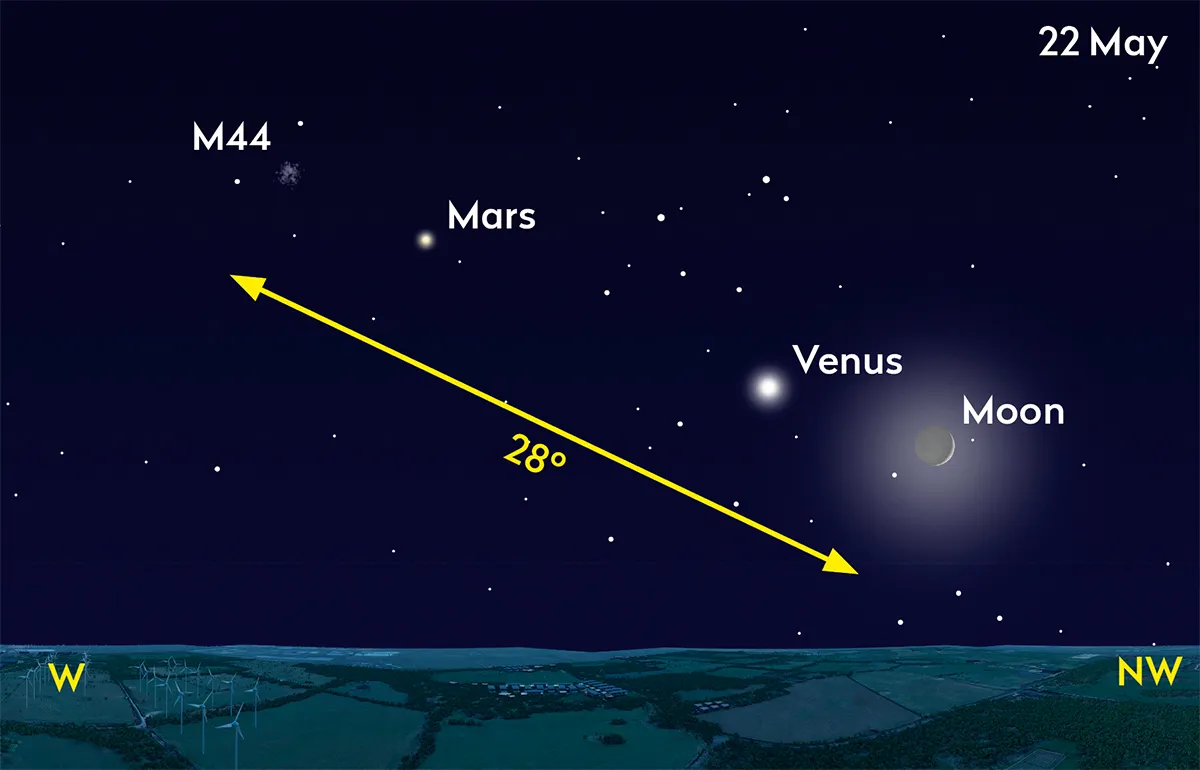Mars is an iconic object in the night sky. Its brightness waxes and wanes over a 2.1-year period, appearing at its most brilliant around opposition.
Mars was at opposition on 8 December 2022 and it now shows only a hint of its former glory.
Its colour is a different matter, the planet retaining the beautiful orange-pink hue that makes it stand out so well.
Mars started May at mag. +1.3, dimming only slightly by month end to mag. +1.6, still an easy naked-eye object.
At that point it starts to battle with the evening twilight, but before it becomes totally engulfed it has one last show up its sleeve.
At the end of May it will be just west of the beautiful binocular open cluster M44, the Beehive Cluster.
This is located in the heart of the winter/spring constellation of Cancer, the Crab.

As we head towards June, Cancer isn’t well-placed and the Beehive becomes engulfed by twilight.
Before it goes, starting in late May, try to find Mars low above the west-northwest horizon after sunset.
If you can follow it as the sky darkens, you shouldn’t have too much trouble locating the stars of the Beehive further to the east.
A good flat horizon is highly recommended.
The dates to note are 1–3 June, the planet appearing inside the main part of the cluster on the evening of 2 June.
Photograph Mars and the Beehive

See whether you can grab a shot of the planet and cluster together.
Catch them early on, say from 22 May, to give yourself plenty of time to get acquainted with the settings needed.
As May draws to a conclusion, the twilight becomes really tricky to deal with. This is a pity because in early June Mars passes directly across the face of the cluster.
Obviously, this is a line-of-sight effect, the cluster being 20 million times more distant than local Mars, but it’s definitely one that’s worth pursuing if you have clear skies and flat horizons.
The twilight conditions pose interesting challenges for astrophotography as the light levels are constantly changing.
As the sky becomes darker, so the altitude of Mars and M44 drop.

This moves them into a region of sky compromised by a thicker, often hazier atmospheric layer.
This in turn will dim Mars and the cluster’s stars.
The whole scene is something of a balancing act. Try to capture it too soon and the sky brightness will ruin the shot.
Wait too long and the low-altitude hazy atmosphere will dim everything, making it hard to grab a good image.
A mid- to long-focal-length lens will work well for the approach shots, while a long-focal-length lens or telescope is ideal for the evening of 2 June and Mars’s transit of the cluster.
A tracking mount is recommended as it will make the pair a lot easier to follow.
However, with a brighter twilight sky, exposures need to be kept relatively short, meaning fixed, non-tracking mounts should work fine too.
If using a DSLR on a fixed platform you may need to up the ISO so exposures are short enough to avoid trailing.
Step 1

There are some lovely chances to capture the Beehive, Mars, Venus and the waxing crescent Moon from 22 May onwards. Around midnight BST on 22 May, the widest Moon–M44 separation is 28 ̊.
Choose a lens that covers say 35–40 ̊; 50mm for full-frame cameras or 30mm focal length for APS-C should work well.
Step 2

If you have a smartphone, why not give that a go as well? It’s recommended to mount the phone with an inexpensive smartphone tripod adaptor for stability. Experiment with the basic mode first.
If that doesn’t work, try a night shoot mode if your camera has one. Alternatively, if it has a pro mode that allows you to adjust settings, try that.
For more advice, read our guide to smartphone astrophotography.
Step 3

For a basic shot with a phone camera, set the focus to manual (MF) and ISO to 400–1600 and experiment with the exposure settings.
The Moon and Venus should record easily and Mars shouldn’t pose too much of an issue either. The cluster stars may be trickier, depending on the capabilities of your phone’s camera under low-light conditions.
Step 4

From 22 May, Mars will be moving closer to the cluster. On that date it lies 6.2˚ to the west of M44, nicely framed by a 240mm lens (full-frame) or a 150mm lens (APS-C).
With a twilight-bright sky, choose a low ISO and a lowish f-number, and adjust the exposure to give a well-saturated but not over-exposed image.
Step 5

Careful tweaking can improve the visibility of the cluster stars. A gentle ‘S’ shape on the Curves adjustment tool and subtle changes to brightness and contrast will bring out their best.
Consider using sharpening too, but be careful not to overdo this as it can create edge fringes that detract from the final result.
Step 6

As we head into June, the separation will decrease, Mars appearing in front of the cluster on 2 June. By this date, twilight will be an issue.
A longer focal length will help you zoom into the cluster and darken the sky slightly. A 500mm lens (full-frame) or 300mm lens (APS-C) will get you right into the action.
Did you photograph Mars's meeting with the Beehive? Don't forget to send us your images!
This article originally appeared in the May 2023 issue of BBC Sky at Night Magazine.



